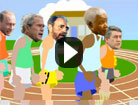Motivation and High Performance
Harvard Business Review’s ‘summer reading’ (their big summer edition) has a big piece on motivation. Timely, as motivation can dip drastically in a downturn, with employees worried about their finances, their job and the future.The piece draws on the trendy ‘neuroscience of leadership’ – using MRI scanners to see which areas of the brain light up to show activity and engagement – and says that there are four key drivers of motivation:
1. The drive to acquire – rewards and experiences
2. The drive to bond – building a sense of belonging
3. The drive to comprehend – work must be meaningful
4. The drive to defend – fair play for all
Stefan Stern, in the FT today, points out that motivation remains a big headache for managers and leaders, regardless of the economic climate. A recent Hay Group survey of more than 3,100 organizations found that 41% of employees felt demotivated by their managers.
This reminds me of a true story my friend Henry Stewart, founder of Happy Computers, likes to begin his presentations with: a manufacturing company noted that its productivity figures went up on the weekend. It couldn’t figure out why, till it dug a little deeper and realized the obvious: the managers didn’t go in on the weekend.
Stern says that the ‘powerful new model’ trumpeted in the HBR doesn’t actually add anything to what we know already which, he says, can be summed up in this paragraph from Frederick Herzberg, author, ironically, of one of the HBR’s most widely-read articles, the 1968 piece “One more time: how do you motivate employees”.
Herzberg’s seminal paragraph is this:
“If I kick my dog…he will move. And when I want him to move again what must I do? I must kick him again. Similarly, I can change a person’s battery, and then recharge it, and then recharge it again. But it is only when one has a generator of one’s own that we can talk about motivation. One then needs no outside stimulation. One wants to do it.”
PS So what’s your role in motivating? Providing inspiration and getting out of the way (apart from stepping in to support and ensure people have the resources they need). Inspired leadership is the piece that is missing in most organizations.









Leave a Reply